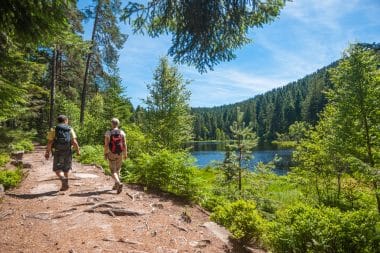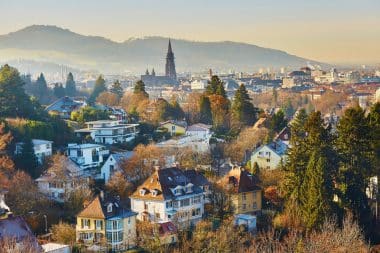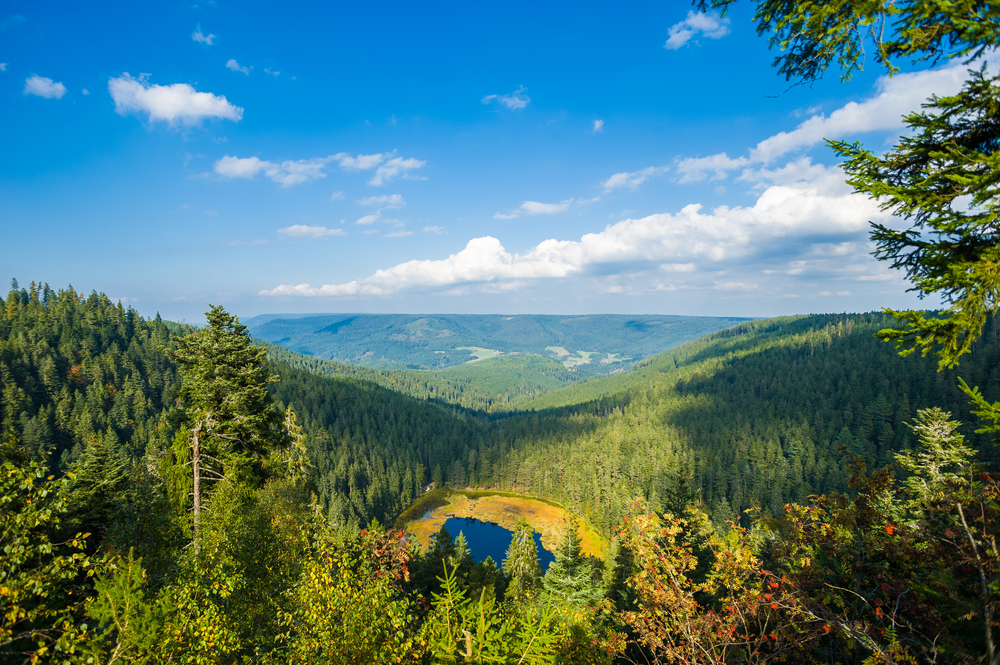The Black Forest is one of the most famous German low mountain ranges and attracts millions of tourists every year as a holiday region. The natural region is rich in streams, rivers and lakes, mountains, dense forests and a variety of gorges. Especially for hikers, the Black Forest offers a variety of interesting routes due to its developed network of paths, of which the Schluchtensteig, the Belchensteig or the Panorama Trail in Baden-Baden are well-known examples. Nature lovers will enjoy the varied landscape here, which leads through valleys and gorges along streams and springs to panoramic vantage points. In addition, Baden-Baden, Freiburg or Villingen-Schwenningen are historic, picturesque towns in the region, which are suitable for both day trips and longer stays. The Black Forest offers wellness tourists with its spas and spas as well as nature fans, families and sports enthusiasts a wide range of opportunities for adventure and relaxation.
Regions and sights

The Black Forest covers a large area that begins south of Karlsruhe with the cities of Baden-Baden and Pforzheim and extends via Freiburg to Basel . The north is characterized by the large Black Forest National Park, which runs between the Black Forest High Road and the valley of the Murg.
The Black Forest Central/North Nature Park is the largest nature park in Germany and covers an area of 4,200 km². The landscape of the national park is characterized by a unique nature and rich flora and fauna. The first is mainly characterized by spruce and fir forests, among which numerous other rare plant species and moors can be found. The forests are home to a variety of woodpeckers, owls and rare bird species such as the capercaillie.
In addition, numerous deer and red deer, bats, pine martens and various snake species live in the region, which are of great interest to animal lovers. A popular destination in the northern Black Forest is the Baden-Baden Panorama Trail, which offers visitors interesting views over the Rhine plain and the mountain landscape. The various cirque lakes such as the Wildsee, the Huzenbacher See or the Buhlbachsee are also popular with day-trippers as resting places due to their walking distance. In the northern Black Forest, there is also an architecturally interesting route, the German Half-Timbered Houses Road, which leads through various small towns such as Neubulach or Zavelstein.
In the latter village there is also a castle ruin at an altitude of 560 m. Baden-Baden is considered a historic spa and cultural centre of the northern Black Forest. Here, tourists and locals alike enjoy cultural highlights such as the Festspielhaus, which is considered the largest opera and concert hall in Germany and regularly offers performances of well-known plays. As a landmark of the city, events such as cabaret or cabaret take place just as often in the Kurhaus. The various thermal baths to which the city owes its status as a spa are also popular with wellness tourists.
The center of the Black Forest
The centre and south of the Black Forest also has a colourful range of sights. Popular excursion destinations such as the town of Gutach, Furtwangen, the hiking area around the Blindensee or the Hexenlochmühle are located here.
Furtwangen is home to the German Clock Museum as a well-known hodgepodge of Black Forest watchmaking. Gutach is home to the Black Forest Open-Air Museum, where guests can witness the historical life in the region with its traditional costumes, houses and working methods. Typical of the district are the traditional farmhouses with their distinctive roofs.
Around Furtwangen lies the Hexenlochtal, where the only mill with two water wheels in the Black Forest can be found and is a popular photo motif. The Blindensee near Schonach, which was named after the blind gentleman who used to live there and is also a high moor, is suitable for excursions. For visitors, the lake can be reached via a wooden walkway, where various signs provide information about the local nature and history.
The South
Very close to the Blindensee, the southern Black Forest begins. The region is characterized by a variety of gorges, hiking routes, lakes and picturesque towns. The most famous of the valleys is the Höllental, which is crossed by the Höllentalbahn.

This was put into operation as early as the 1880s and runs at steep heights between the cities of Freiburg and Villingen and offers visitors worthwhile views over gorges and waters such as the famous Titisee. The Southern Black Forest Nature Park, Germany’s second largest nature park, is another natural landscape in the region that stretches to the Swiss border. The paths of the nature park run directly through the Schluchtensteig, which is a popular hiking trail network with mostly natural paths.
The Schluchtensteig connects a network of 119 km of hiking trails that wind through stony valley landscapes between streams and wooden bridges. A well-known route lies between the Schattenmühle in the Wutach Gorge and leads to the community of Oberfischbach am Schluchsee, the largest lake in the Black Forest. The municipality of the same name is a well-known health resort and in summer a popular destination for bathers and sports sailors, who regularly organize regattas here.
In addition to its lakes, the southern Black Forest is also known for its waterfalls. The Triberg Waterfalls, for example, which pour into the Triberg basin near Freiburg, are impressive. In addition to a Black Forest museum with historical insights, Triberg is also home to the world’s largest walk-in cuckoo clock, which is also becoming increasingly popular with foreign tourists. At about 25 years old, this is quite young and is classically operated with a pendulum drive, which visitors can examine inside. Another popular hiking route in the deepest south is the Wolfsschlucht near Kandern, which is a green valley criss-crossed by numerous rock formations. In the Münstertal valley, the monastery of St. Trudpert is enthroned as a former Benedictine monastery, where numerous concerts and cultural events take place in summer. In this region, the Black Forest borders on the warm wine-growing region in the Rhine plain of the Breisgau.
Fribourg
The cultural centre of the southern Black Forest and the region as a whole is Freiburg, the southernmost city in Germany at the western foot of the Black Forest. For visitors, the sunny city is one of the must-visits, the status of which is justified by the range of sights. Freiburg is known for its “Bächle”, artificially created watercourses of the Dreisam River, which have existed since the Middle Ages. From the Schlossberg, visitors can overlook the entire old town. Here are other sights such as the Martinstor, the Freiburg Cathedral and the two still preserved fortifications of the city, the Schwabentor and the Martinstor. The cultural scene is just as strongly represented with various museums, the municipal theatre and a large number of cinemas as it is in the sporting field with the first division football team SC Freiburg, which plays its games in the Black Forest Stadium. As a wine region, Freiburg is represented with older grape varieties such as Chasselas, Pinot Blanc and Pinot Gris, but also red wine of high-quality varieties.
Facts about the Black Forest
-
Natural wonder:
- The Black Forest covers around 6,000 square kilometers and offers a diverse landscape of dense forests, rolling hills, deep valleys, and clear lakes.
- Highlights are the Feldberg, the highest peak in the Black Forest, the Titisee and the Schluchsee, two picturesque lakes, and the Wutach Gorge, one of the most spectacular gorges in Germany.
- Outdoor activities such as hiking, cycling, skiing and wellness in the numerous health resorts make the Black Forest a paradise for nature lovers and adventurers.
-
Cultural heritage:
- The Black Forest is rich in traditional culture, folklore and history. Visitors can explore historic towns such as Freiburg im Breisgau, charming Freudenstadt, and picturesque Gengenbach.
- Traditional Black Forest houses with their typical wooden structures, the famous cuckoo clocks and the artistic costumes give an insight into the regional culture and craftsmanship.
- Museums such as the German Clock Museum in Furtwangen and the Black Forest Open-Air Museum Vogtsbauernhof offer exciting insights into the history and traditions of the Black Forest.
-
Culinary delights:
- The Black Forest is not only known for its nature and culture, but also for its delicious cuisine. Sample local specialties such as Black Forest ham, Black Forest cake, and the famous Black Forest cherry brandy.
- Visit traditional inns and quaint breweries to experience authentic Black Forest cuisine and the warm hospitality of the locals.
-
Practical information:
- How to get there: The Black Forest is easy to reach by public transport and car. The nearest airports are Stuttgart and Baden-Baden.
- Accommodation: A variety of accommodation is available, from cozy guesthouses and apartments to luxurious wellness hotels.
- Best time to visit: The Black Forest is worth a visit at any time of the year. During the summer, warm temperatures and outdoor activities beckon, while in winter, snow-covered landscapes offer ideal conditions for winter sports.


